Model-based reinforcement learning for flow control
Andre Weiner, Janis Geise
TU Dresden, Chair of Fluid
Mechanics
Outline
- closed-loop active flow control (AFC)
- proximal policy optimization (PPO)
- model ensemble PPO (MEPPO)
- application: fluidic pinball
Closed-loop active flow control (AFC)
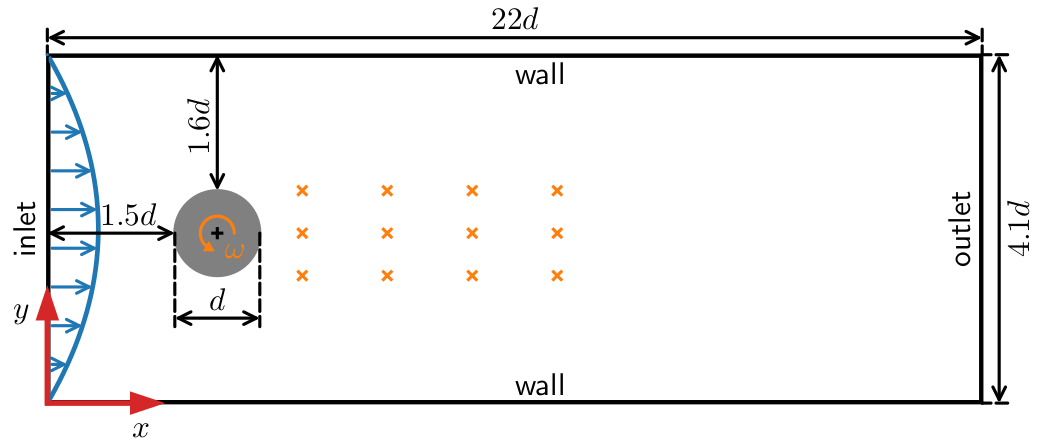
Flow past a cylinder in a narrow channel at $Re=\bar{U}_\mathrm{in}d/\nu = 100$.
Closed-loop control starts at $t=4s$.
motivation for closed-loop AFC
- (potentially) more efficient than open-loop control
- optimal control under changing conditions
How to design the control system?
$\rightarrow $ end-to-end optimization via simulations
Training cost DrivAer model
- $5$ hours/simulation (1000 MPI ranks)
- $10$ parallel simulations
- $100$ iterations $\rightarrow 20$ days turnaround time
- $20\times 24\times 10\times 1000 \approx 5\times 10^6 $ CPUh
- $0.01-0.05$ EUR/CPUh $\rightarrow 0.5-2$ mEUR
CFD simulations are expensive!
Proximal policy optimization (PPO)
Create an intelligent agent that learns to map states to actions such that expected returns are maximized.
experience tuple at step $n$ $$ (S_n, A_n, R_{n+1}, S_{n+1}) $$
trajectory over $N$ steps $$\tau = \left[ (S_0, A_0, R_1, S_1), \ldots ,(S_{N-1}, A_{N-1}, R_N, S_N)\right]$$
return - dealing with sequential feedback
$$ G_n = R_{n+1} + R_{n+2} + ... + R_N $$
discounted return $$ G_n = R_{n+1} + \gamma R_{n+2} + \gamma^2 R_{n+3} + ... \gamma^{N-1}R_N $$
$\gamma$ - discounting factor, typically $\gamma = 0.99$
learning what to expect in a given state - value function loss
$$ L_V = \frac{1}{N_\tau N} \sum\limits_{\tau = 1}^{N_\tau}\sum\limits_{n = 1}^{N} \left( V(S_n^\tau) - G_n^\tau \right)^2 $$
- $\tau$ - trajectory (single simulation)
- $S_n$ - state/observation (pressure)
- $V$ - parametrized value function
- clipping not included
Was the selected action a good one?
$$\delta_n = R_n + \gamma V(S_{n+1}) - V(S_n) $$ $$\delta_{n+1} = R_n + \gamma R_{n+1} + \gamma^2 V(S_{n+2}) - V(S_n) $$
$$ A_n^{GAE} = \sum\limits_{l=0}^{N-n} (\gamma \lambda)^l \delta_{n+l} $$
- $\delta_n$ - one-step advantage estimate
- $A_n^{GAE}$ - generalized advantage estimate

The policy network parametrizes a PDF over possible actions.
make good actions more likely - policy objective function
$$ J_\pi = \frac{1}{N_\tau N} \sum\limits_{\tau = 1}^{N_\tau}\sum\limits_{n = 1}^{N} \mathrm{min}\left[ \frac{\pi(A_n|S_n)}{\pi^{old}(A_n|S_n)} A^{GAE,\tau}_n, \mathrm{clamp}\left(\frac{\pi(A_n|S_n)}{\pi^{old}(A_n|S_n)}, 1-\epsilon, 1+\epsilon\right) A^{GAE,\tau}_n\right] $$
- $\pi$ - current policy
- $\pi^{old}$ - old policy (previous episode)
- entropy not included
- $J_\pi$ is maximized
Model ensemble PPO (MEPPO)
https://arxiv.org/html/2402.16543v1Idea: replace CFD with model(s) in some episodes
Challenge: dealing with surrogate model errors
for e in episodes:
if not models_reliable():
sample_trajectories_from_simulation()
update_models()
else:
sample_trajectories_from_models()
update_policy()
Based on Model Ensemble TRPO.
auto-regressive surrogate models with weights $\theta_m$
$$ m_{\theta_m} : (\underbrace{S_{n-d}, \ldots, S_{n-1}, S_n}_{\hat{S}_n}, A_n) \rightarrow (S_{n+1}, R_{n+1}) $$
$\mathbf{x}_n = [\hat{S}_n, A_n]$ and $\mathbf{y}_n = [S_{n+1}, R_{n+1}]$
$$ L_m = \frac{1}{|D|}\sum\limits_{i}^{|D|} (\mathbf{y}_i - m_{\theta_m}(\mathbf{x}_i))^2 $$
How to sample from the ensemble?
- pick initial sequence from CFD
- generate model trajectories
- select random model
- sample action
- predict next state
When are the models reliable?
- evaluate policy for every model
- compare to previous policy loss
- switch if loss did not decrease for
at least $N_\mathrm{thr}$ of the models
Application: fluidic pinball
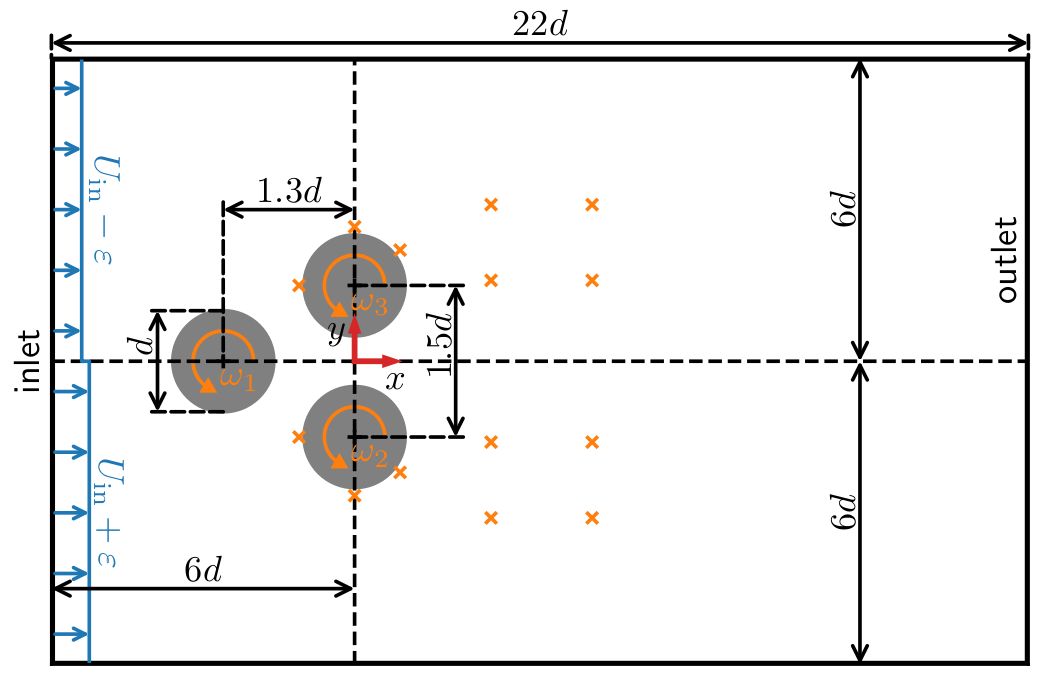
Fluidic pinball at $Re=\bar{U}_\mathrm{in}d/\nu = 100$; $\omega^\ast_i = \omega d/U_\mathrm{in} \in [-0.5, 0.5]$.
reward at step $n$
$$ c_x = \sum\limits_{i=1}^3 c_{x,i},\quad c_y = \sum\limits_{i=1}^3 c_{y,i} $$
$$ R_n = 1.5 - (c_{x,n} + 0.5 |c_{y,n}|) $$
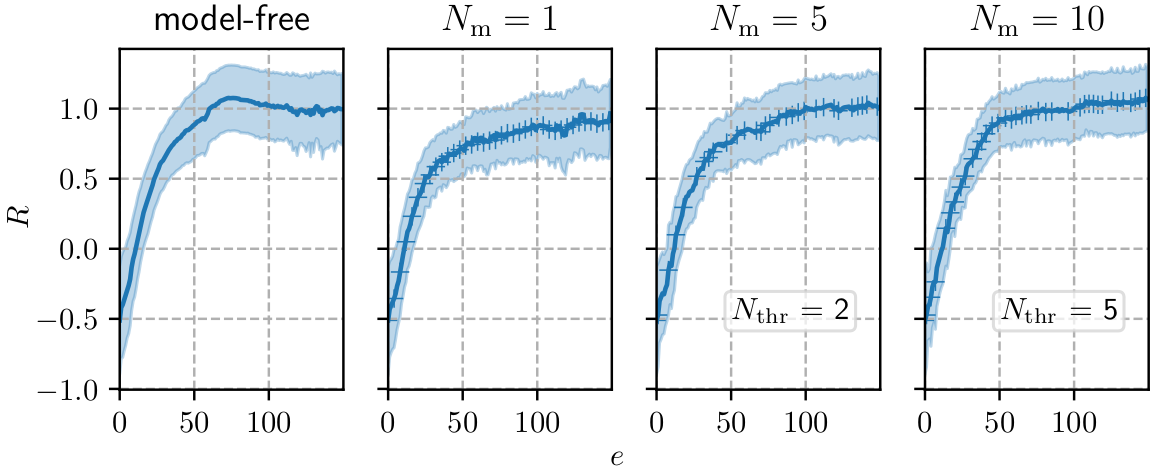
Mean reward $R$ per episode; $N_\mathrm{m}$ - ensemble size; $N_\mathrm{thr}$ - switching criterion.
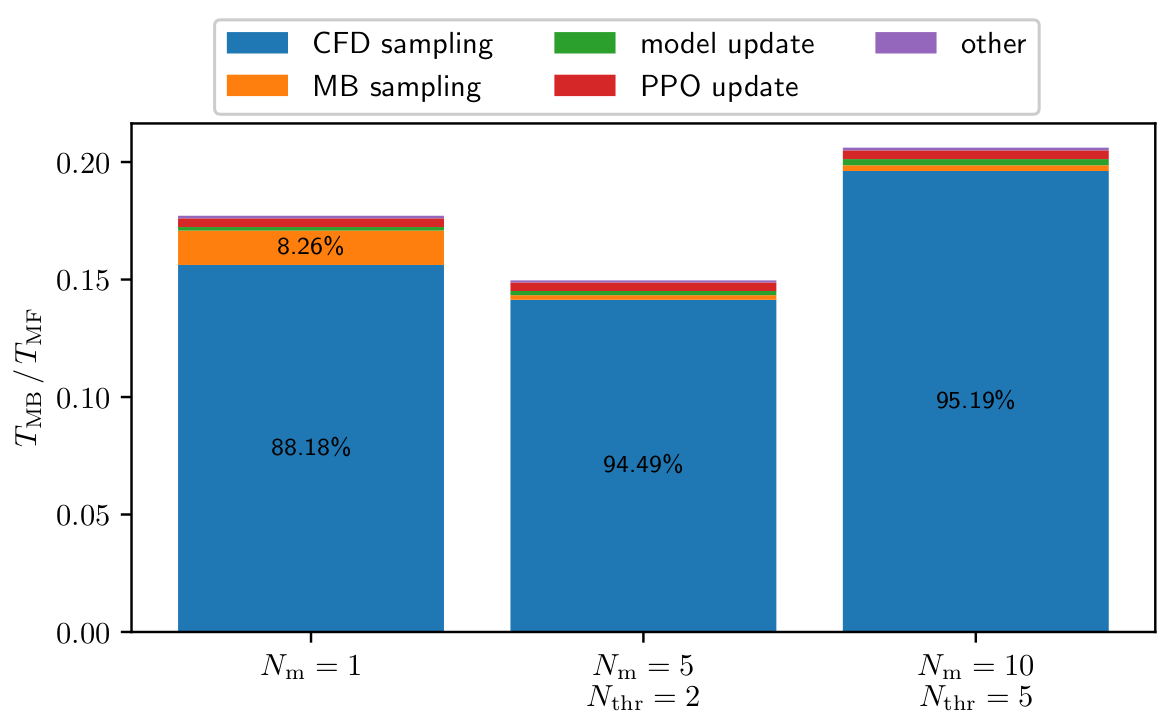
Composition of model-based training time $T_\mathrm{MB}$ relative to model-free training time $T_\mathrm{MF}$.
Closed-loop control starts at $t=200s$.
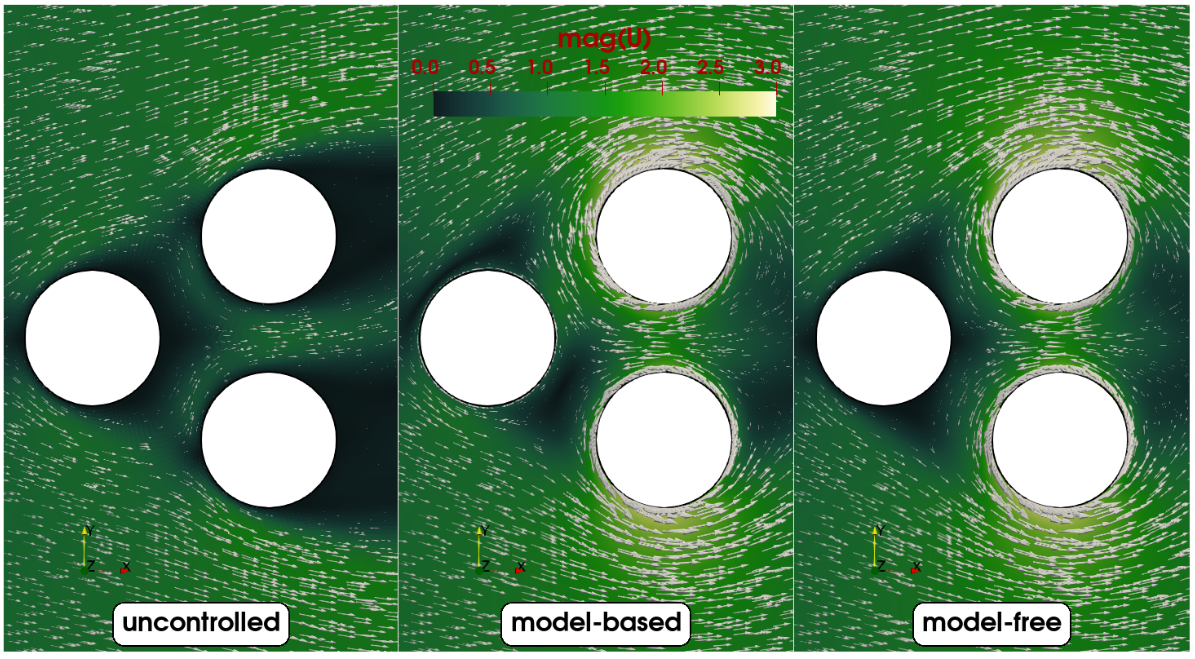
Snapshot of velocity fields (best policies).
toward realistic AFC applications
- improved surrogate modeling
- hyperparameter optimization
- "smart" trajectory sampling
Thank you for you attention!

Slides

GitHub
